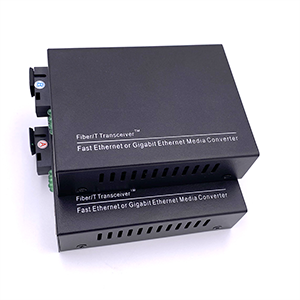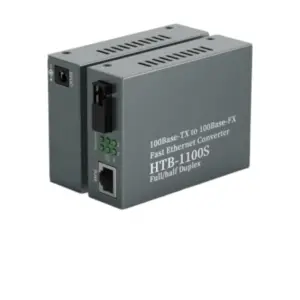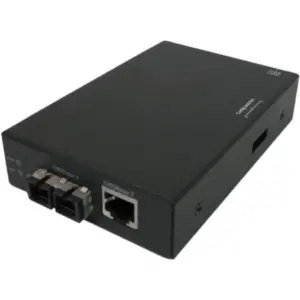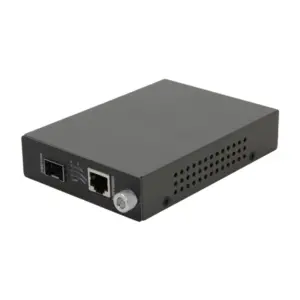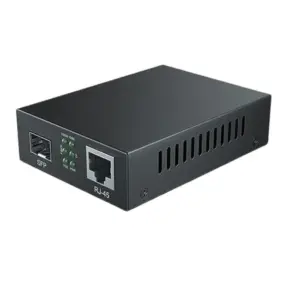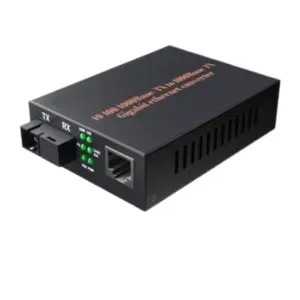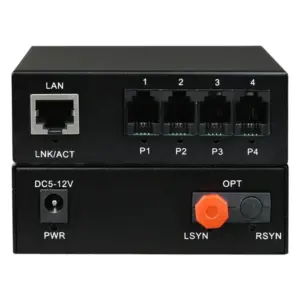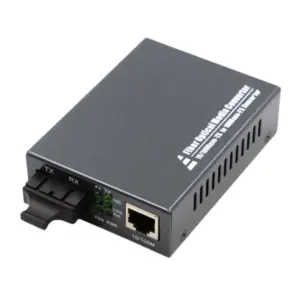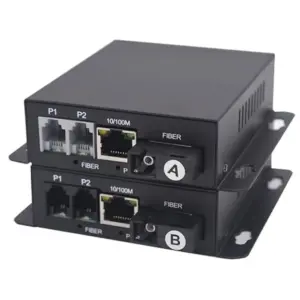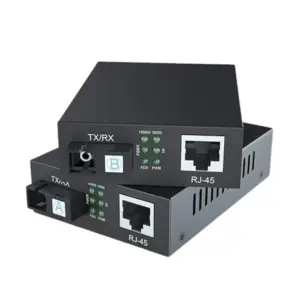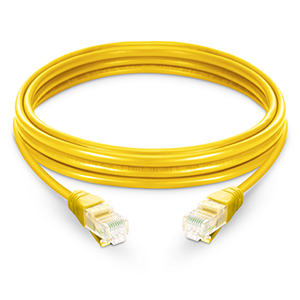In this article, I will give you an in-depth look at the capabilities and broad application areas of Fiber Media Converters. We will introduce the definition, basic principles and conversion process between different media of Fiber Media Converters. By understanding the advantages of Fiber Media Converters in multi-media interconnection, extended transmission distance, protocol conversion and compatibility, as well as network expansion and topology flexibility, you will be able to realize why Fiber Media Converters are an ideal choice for different network needs. Let’s explore the excellent features of Fiber Media Converters and the huge benefits they can bring to your network architecture!
What are Fiber Media Converters
Fiber Media Converters are network devices used to convert between different network media. They can convert optical fiber signals and electrical signals to and from each other, allowing different types of network equipment to connect and communicate. The following will explain the definition and basic principles of Fiber Media Converters, introduce its conversion process with different media, and provide an overview of its basic structure and working mode.
-
Definition and rationale:
Fiber Media Converters are network devices used to convert between different types of network media. They can convert fiber optic signals into electrical signals, or electrical signals into fiber optic signals, to enable connections and communications between different types of network equipment. Through the process of photoelectric conversion and electro-optical conversion, Fiber Media Converters are able to transmit and convert data signals between different media.
-
Conversion process:
The main function of Fiber Media Converters is to convert between optical fiber signals and electrical signals. When converting fiber optic signals to electrical signals, Fiber Media Converters receive the optical signals transmitted by fiber optics, convert them into electrical signals, and transmit the signals through the cable to the target device. When converting electrical signals to fiber optic signals, Fiber Media Converters receive the electrical signal, convert it into an optical signal, and transmit the signal over the fiber optic to the target device. In this way, different types of devices can connect and communicate through Fiber Media Converters.
-
Basic structure and working mode:
Fiber Media Converters are usually composed of the following components:
- Photoelectric converter (Transceiver): Responsible for converting optical signals into electrical signals, or electrical signals into optical signals.
- Media interface: used to connect optical fibers and cables to realize signal transmission.
- Power supply: Provides electrical power to drive photoelectric converters and other components.
The working modes of Fiber Media Converters can be divided into two types: half-duplex and full-duplex:
- Half-duplex mode: In half-duplex mode, Fiber Media Converters can only transmit data in one direction and cannot send and receive at the same time. This mode is suitable for application scenarios with lower bandwidth requirements.
- Full-duplex mode: In full-duplex mode, Fiber Media Converters can send and receive data at the same time, achieving two-way communication. This mode is suitable for application scenarios with high bandwidth requirements.
Fiber Media Converters can be configured and deployed as needed to meet different network needs. They are widely used in various network environments, such as enterprise networks, data centers, telecommunications, and wide area networks, to provide interconnection capabilities for devices in different media.
Fiber Media Converters multi-media interconnection
Fiber Media Converters have many advantages in multi-media interconnection. The following will explore these advantages, explain how they enable conversion between fiber and copper, and highlight their importance in mixed-media network environments.
Advantages:
-
Interconnecting different media: Fiber Media Converters allow interconnection between different media, such as optical fiber and copper wire. This means that devices using different media can be connected together to achieve interoperability and communication without the need to replace equipment or rewire.
-
Long-distance transmission: Optical fibers generally have longer transmission distances and lower signal attenuation. By using Fiber Media Converters to convert optical fiber signals into copper wire signals, you can overcome the limitations of copper wire transmission distance and achieve long-distance data transmission.
-
Anti-interference performance: Optical fiber signals have better anti-interference performance against electromagnetic interference. Compared with copper wires, it can ensure stable and reliable transmission of signals. By using Fiber Media Converters to convert copper wire signals to fiber optic signals, the signal’s anti-interference ability can be improved and signal losses and errors during transmission can be reduced.
-
High bandwidth support: Fiber optics typically have higher bandwidth capabilities and can support greater data transfer rates and capacities. By using Fiber Media Converters to convert copper wire signals into fiber optic signals, higher bandwidth support can be achieved to meet the needs for large data volumes and high-speed transmission.
-
Fiber optic and copper wire conversion process:
Fiber Media Converters achieve conversion between optical fiber and copper wire through the process of photoelectric conversion and electro-optical conversion:
- Photoelectric conversion: When the optical fiber signal needs to be converted into a copper wire signal, the photoelectric converter receives the optical signal transmitted by the optical fiber and converts it into an electrical signal. The signal is then transmitted over the cable to the target device.
- Electro-optical conversion: When the copper wire signal needs to be converted into an optical fiber signal, the photoelectric converter receives the electrical signal, converts it into an optical signal, and transmits it to the target device through the optical fiber.
-
Importance in mixed media network environments:
In real-world network environments, mixed-media networks are very common. Different devices and network facilities may use different media, such as fiber optics and copper wires. In this case, Fiber Media Converters play an important role, they allow interconnection and communication between these devices and networks. By using Fiber Media Converters, interconnections can be easily implemented in mixed media networks, improving network flexibility and scalability.
In short, Fiber Media Converters have many advantages in multi-media interconnection, including interconnecting different media, long-distance transmission, anti-interference performance and high-bandwidth support. They realize conversion between optical fibers and copper wires through the process of photoelectric conversion and electro-optical conversion, and in mixed-media network environments, they play an important role in achieving effective interconnection and interoperability of equipment and networks.
Fiber Media Converters extend transmission distance
Fiber Media Converters offer many benefits in extending transmission distance. The following describes these benefits, explains how long-distance data transmission is achieved through fiber optic conversion, and provides application examples of Fiber Media Converters in long-distance communications and WAN connections.
Benefits:
-
Signal attenuation compensation: Optical fiber communication has low signal attenuation characteristics and can transmit signals over longer distances while reducing the loss of signal quality. By using Fiber Media Converters to convert copper wire signals to optical fiber signals, the loss of the signal during transmission can be compensated, thereby extending the transmission distance.
-
Free from electromagnetic interference: Fiber optic signals are less susceptible to electromagnetic interference than copper wire signals. By using Fiber Media Converters to convert copper wire signals to fiber optic signals, data transmission can be freed from electromagnetic interference, thereby improving transmission quality and stability.
-
Long-distance transmission: Optical fiber communication has low transmission loss and can achieve data transmission over longer distances. By using Fiber Media Converters to convert copper wire signals into optical fiber signals, you can overcome the limitations of copper wire transmission distance and achieve long-distance data transmission of tens or even hundreds of kilometers.
-
Fiber optic conversion enables long-distance data transmission:
Fiber Media Converters enable long-distance data transmission by converting copper wire signals to fiber optic signals:
- Optoelectric conversion: Fiber Media Converters receive electrical signals transmitted by copper wires and convert them into optical signals. These optical signals are transmitted through optical fibers, overcoming the limitations of copper wire transmission distances.
- Electro-optical conversion: At the target device, another Fiber Media Converters receives the optical signal transmitted by the optical fiber and converts it back to an electrical signal for processing and use by the target device.
Application cases:
Fiber Media Converters have a wide range of applications in long-distance communications and WAN connections, here are some examples:
-
Telecommuting: In a telecommuting environment, employees may be required to perform work away from headquarters. By using Fiber Media Converters, reliable fiber optic connections can be established between remote office locations and headquarters for high-quality remote communications and data transmission.
-
Data center connectivity: Data centers often require data transmission over long distances to connect different servers and devices. By using Fiber Media Converters, you can extend the transmission distance between data centers to achieve high-speed data transmission and reliable connections.
-
WAN connectivity: Fiber Media Converters also play an important role in WAN connectivity. By converting copper wire signals into optical fiber signals, long-distance data transmission and connections can be achieved in wide area networks, providing high bandwidth and reliable network connections.
-
In summary, Fiber Media Converters have benefits in extending transmission distance, including signal attenuation compensation, protection from electromagnetic interference, and long-distance transmission. Through optical fiber conversion, copper wire signals are converted into optical fiber signals, and long-distance data transmission can be achieved. In remote communications and WAN connections, Fiber Media Converters are widely used, including telecommuting, data center connections and WAN connections, to achieve high-quality remote communications and reliable data transmission.
Fiber Media Converters protocol conversion and compatibility
Fiber Media Converters have many advantages in protocol conversion and compatibility. The following will explore these advantages, explain how to achieve seamless connections between different protocols through converters, and highlight the importance of Fiber Media Converters in network upgrades and compatibility migrations.
Advantages:
-
Protocol conversion: Fiber Media Converters can achieve conversion between different protocols, such as Ethernet, Fast Ethernet, Gigabit Ethernet, etc. This enables devices with different protocols to communicate and interoperate seamlessly without the need to replace devices or perform complex configurations.
-
Compatibility: Fiber Media Converters have broad compatibility and can interconnect with a variety of network devices and protocols. Whether using fiber optic or copper wire, whether using single mode fiber or multimode fiber, Fiber Media Converters can provide compatible and interconnected solutions.
-
Flexibility: Fiber Media Converters can be configured and deployed according to actual needs. They can support different transmission rates, fiber types and connection interfaces to meet the flexibility of different network environments and requirements.
-
Seamless connection between different protocols:
By using Fiber Media Converters, seamless connections between different protocols can be achieved:
-
Protocol converter: The protocol converter in Fiber Media Converters can convert the signal of one protocol into the signal of another protocol. For example, it can convert Ethernet signals to Fast Ethernet signals, or Fast Ethernet signals to Gigabit Ethernet signals.
-
Conversion process: When the signal passes through the converter, the converter parses the protocol of the input signal and then generates an output signal that is compatible with the target protocol. In this way, devices with different protocols can connect and communicate through the converter.
-
-
The importance of network upgrades and compatibility migration:
Fiber Media Converters play an important role in network upgrades and compatibility migrations. During network upgrades, it may be necessary to interface old devices and protocols with new ones. By using Fiber Media Converters, you can easily achieve compatibility between old and new equipment, extend the life of existing equipment, and implement upgrade plans gradually without having to replace all equipment at once.
Furthermore, Fiber Media Converters are also useful when organizations need to migrate to a new network environment or protocol. They can help achieve a smooth transition during upgrades or migrations and ensure interoperability and connectivity between old and new equipment.
In summary, Fiber Media Converters has advantages in protocol conversion and compatibility, including protocol conversion, compatibility, and flexibility. Through converters, seamless connections between different protocols can be achieved. In network upgrades and compatibility migrations, Fiber Media Converters play an important role in extending the service life of existing equipment, achieving compatibility between old and new equipment, and achieving a smooth network upgrade and migration process.
Fiber Media Converters network expansion and topology flexibility
Fiber Media Converters offer many advantages in terms of network expansion and topology flexibility. The following will introduce these advantages, explain how to achieve flexible changes in network topology through converters, and provide application cases of Fiber Media Converters in network expansion and equipment migration.
Advantages:
-
Network Expansion: Fiber Media Converters can help extend the scope and size of your network. By converting signals from copper wires to fiber optics, the transmission distance limitations of copper wires are overcome, allowing data to be transmitted over longer distances. This allows the network to cover a larger area and connect devices that are far away from the backbone network.
-
Topology flexibility: Fiber Media Converters provide network topology flexibility. They can be used in different topologies including star, ring, bus, hybrid, etc. This enables network designers to select the most suitable topology based on actual needs and constraints, and to flexibly adjust and change it as needed.
-
Multiple media interconnection: Fiber Media Converters can realize interconnection between different media, such as interconnection between copper wires and optical fibers. This enables different devices and media in the network to connect and communicate seamlessly, providing greater flexibility and interoperability.
-
Flexible changes in network topology:
By using Fiber Media Converters, flexible changes in network topology can be achieved:
-
Device connection: Fiber Media Converters can be used to directly connect different types of devices, such as connecting fiber to copper devices or connecting copper to fiber devices. In this way, flexible connections can be established between different types of devices based on actual needs and topology requirements.
-
Topology adjustment: Fiber Media Converters can also be used to adjust the network topology. For example, when you need to add a new device or change the location of the device, you can use a converter to connect it to the existing network without changing the entire network structure.
-
Application cases:
Fiber Media Converters have many application cases in network expansion and device migration. Here are some examples:
-
Network expansion: When the network needs to cover a larger area, Fiber Media Converters can be used to convert the signal from copper wire to optical fiber to extend the transmission distance and range. This is useful for building campus networks, metropolitan area networks, or networks that span large corporate sites.
-
Device migration: When a device needs to be moved to a new location or a new connection established, Fiber Media Converters can help achieve a smooth migration of the device. By connecting the device to a converter in the existing network, the device can be easily moved to a new location without rewiring or changing the entire network structure.
-
Network connection adjustment: Fiber Media Converters can be used to adjust network connections during network changes or upgrades. For example, when replacing network equipment or migrating to a new network protocol, converters can be used to achieve interconnection and communication between old and new equipment.
-
In summary, Fiber Media Converters have advantages in network expansion and topology flexibility, including network expansion, topology flexibility and multiple media interconnections. Through converters, flexible changes in network topology can be achieved, including device connection and topology adjustment. In terms of network expansion and device migration, Fiber Media Converters have a variety of application cases, including network expansion, device migration, and network connection adjustment.
Summary
Thank you for reading our blog! Through the discussion in this article, you will have a more comprehensive understanding of the functions and wide application areas of Fiber Media Converters. Fiber Media Converters enable interconnection between different media through its unique conversion process. Whether it is the conversion of fiber optic and copper wires, or the seamless connection between different protocols, Fiber Media Converters can play an important role.
With Fiber Media Converters, you can flexibly change the network topology to achieve network expansion and device migration. We provide flexible solutions to help you cope with changing network needs and easily build a network architecture with topological flexibility. If you have any needs or questions about your converters, our team is here to provide you with professional support.
Fiber Media Converter FAQ
Fiber media converters are commonly used in scenarios where there is a need to connect fiber optic and copper-based devices or networks. They are often used in telecommunications, data centers, industrial environments, and enterprise networks.
The main purpose of using a fiber media converter is to extend the reach of a network by converting signals between different media types. It allows for the transmission of data over longer distances and provides flexibility in network design and connectivity options.
A fiber media converter receives incoming data signals from one media type, such as copper Ethernet, and converts them into a format suitable for transmission over fiber optic cables. It then converts the signals back to the original media type at the receiving end.
Yes, fiber media converters can support different types of fiber optic cables, such as single-mode and multimode fibers. They are designed to accommodate the specific requirements of different fiber types and can be used in various fiber network configurations.
Yes, most fiber media converters are plug-and-play devices, which means they can be easily installed and require minimal configuration. They usually have auto-negotiation capabilities and can automatically detect and adjust to the connected network’s settings.
Yes, fiber media converters support different data rates to match the requirements of the connected devices or networks. They can handle various speeds, such as 10/100/1000 Mbps for Ethernet, and even higher speeds for fiber optic networks.
Yes, fiber media converters can be used for long-distance transmissions. Fiber optic cables have the advantage of longer reach compared to copper cables, and fiber media converters facilitate the extension of network connectivity over greater distances.
Yes, some fiber media converters can also convert between different network protocols, such as Ethernet, Fast Ethernet, Gigabit Ethernet, or even legacy protocols like RS-232 or RS-485. This enables the integration of different types of devices and networks.
Yes, fiber media converters can be used in both single-mode and multimode fiber networks. They are designed to be compatible with either fiber type and can be selected based on the specific network requirements.

